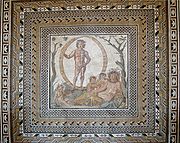
Sentinum
Encyclopedia

Marche
The population density in the region is below the national average. In 2008, it was 161.5 inhabitants per km2, compared to the national figure of 198.8. It is highest in the province of Ancona , and lowest in the province of Macerata...
region in Italy
Italy
Italy , officially the Italian Republic languages]] under the European Charter for Regional or Minority Languages. In each of these, Italy's official name is as follows:;;;;;;;;), is a unitary parliamentary republic in South-Central Europe. To the north it borders France, Switzerland, Austria and...
, lying a kilometre in the low ground at the east of the existing town of Sassoferrato
Sassoferrato
Sassoferrato is a town and comune of the province of Ancona in the Marche region of Italy.-History:To the south of the town lie the ruins of the ancient Sentinum, on the Via Flaminia...
. Its ruins were identified in 1890 and published by T. Buccolini.
The foundations of the city walls are preserved, and city gates a road, cisterns and remains of houses have been discovered, including several mosaic pavements and inscriptions of the latter half of the 3rd century AD, including three important tabulae patronatus, recording legal ratifications of civic appointments of official patrons.
In the neighborhood, the Battle of Sentinum
Battle of Sentinum
The Battle of Sentinum was the decisive battle of the Third Samnite War, fought in 295 BC near Sentinum , in which the Romans were able to overcome a formidable coalition of Samnites, Etruscans, Umbrians, and their Gallic allies...
took place, in which the Romans defeated the combined forces of the Samnites and Gauls in 295 BC
295 BC
Year 295 BC was a year of the pre-Julian Roman calendar. At the time it was known as the Year of the Consulship of Rullianus and Mus...
. It sided with Anthony
Anthony
Anthony, commonly shortened to Tony, may refer to:-Ancient and medieval Christianity:* St. Anthony the Great, of Egypt, 4th century founder of Christian monasticism* St. Anthony the Hermit , 5th century hermit of Italy and Gaul...
but was taken and destroyed in 41 BC
41 BC
Year 41 BC was either a common year starting on Wednesday or Thursday or a leap year starting on Tuesday, Wednesday or Thursday of the Julian calendar and a leap year starting on Wednesday of the Proleptic Julian calendar...
by Salvidienus Rufus leading troops of Octavian
Augustus
Augustus ;23 September 63 BC – 19 August AD 14) is considered the first emperor of the Roman Empire, which he ruled alone from 27 BC until his death in 14 AD.The dates of his rule are contemporary dates; Augustus lived under two calendars, the Roman Republican until 45 BC, and the Julian...
. It was replanned under a regular urbanisation and continued to exist under the Empire, as a municipium
Municipium
Municipium , the prototype of English municipality, was the Latin term for a town or city. Etymologically the municipium was a social contract between municipes, the "duty holders," or citizens of the town. The duties, or munera, were a communal obligation assumed by the municipes in exchange for...
, never (as some wrongly suppose) a colonia
Colonia (Roman)
A Roman colonia was originally a Roman outpost established in conquered territory to secure it. Eventually, however, the term came to denote the highest status of Roman city.-History:...
. From a thermae
Thermae
In ancient Rome, thermae and balnea were facilities for bathing...
of the earliest Empire a large figured mosaic pavement is preserved in the Museo Nazionale delle Marche. A 2nd-century colored mosaic of Mithra
Mithra
Mithra is the Zoroastrian divinity of covenant and oath. In addition to being the divinity of contracts, Mithra is also a judicial figure, an all-seeing protector of Truth, and the guardian of cattle, the harvest and of The Waters....
-Sol
Sol (mythology)
Sol was the solar deity in Ancient Roman religion. It was long thought that Rome actually had two different, consecutive sun gods. The first, Sol Indiges, was thought to have been unimportant, disappearing altogether at an early period. Only in the late Roman Empire, scholars argued, did solar cult...
is conserved in the Glyptothek
Glyptothek
The Glyptothek is a museum in Munich, Germany, which was commissioned by the Bavarian King Ludwig I to house his collection of Greek and Roman sculptures . It was designed by Leo von Klenze in the Neoclassical style, and built from 1816 to 1830...
, Munich; Mithraic bas-relief of animals representing the stages of the initiate's progress were reused in the Church of Santa Croce, and Mithraic inscriptions are recorded.
Civic life at Sentinum seems to have collapsed at the time of the invasion of Alaric I
Alaric I
Alaric I was the King of the Visigoths from 395–410. Alaric is most famous for his sack of Rome in 410, which marked a decisive event in the decline of the Roman Empire....
and not to have been renewed.
The site and its environs, which have been excavated under the joint auspices of the Università degli studi di Genova (Prof.ssa Maura Medri) and the Università degli studi di Urbino "Carlo Bo" (Prof. Sergio Rinaldi Tufi) are protected as the Archaeological park of Sentinum.

